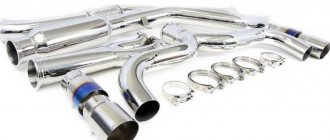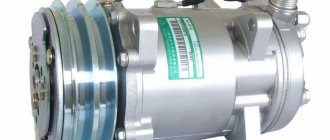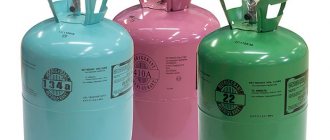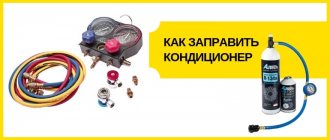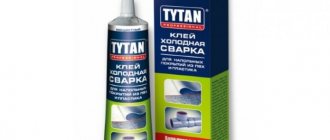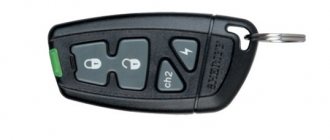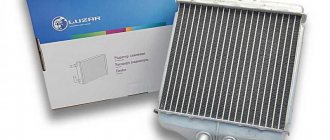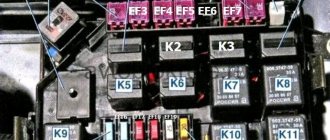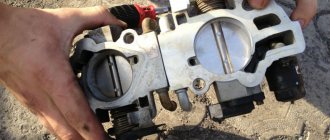Car air conditioner cleaning and disinfection
Cleaning the car air conditioner and disinfecting it are an integral part of preparing a car equipped with air conditioning or climate control for the summer season. All car air conditioners require constant attention and care. The main malfunctions of car air conditioners are the lack of cold and an unpleasant odor from the ventilation system.
For antibacterial cleaning of car air conditioners, there are many special products that can be purchased at every car store. But how effective are they, and how to use them correctly?
In this article we will talk about how and the best way to clean a car air conditioner, and about the rules for caring for the air conditioning system in a car. And at the bottom of the page , watch a video about disinfecting a car air conditioner with your own hands using an inexpensive product purchased at a pharmacy.
But first, we suggest you understand why you need to periodically clean your car air conditioner and carry out antibacterial treatment.
Why do you need antibacterial cleaning of a car air conditioner?
To understand why you need to regularly clean and disinfect the air conditioner in your car, let's first understand how it works and works.
The car air conditioning system is filled with refrigerant. Under high pressure pumped by the compressor, the refrigerant enters the evaporator (heat exchanger located in the cabin), where it changes from a liquid state to gas, and is cooled sharply.
Moisture condenses on the ice evaporator, which mixes with dust in the air flow blowing on the evaporator. Over time, dirt accumulates and develops mold, mildew, and bacteria.
In order to reduce to a minimum the amount of dirt and dust entering the ventilation and air conditioning system with air, there are special cabin filters in cars.
But in addition to dirty air inside the car, other dangers may threaten the air conditioner:
- Road dirt gets into the space between the engine cooling radiator and the car air conditioning radiator (condenser). This leads to impaired cooling of the air conditioning compressor and its breakdown, followed by expensive repairs.
- Dirt is also a cause of corrosion of aluminum parts of the car air conditioner. Any microcrack can lead to a refrigerant leak, which again will lead to the need to repair the air conditioning system in the car.
Thus, timely cleaning and antibacterial treatment of the car air conditioner will help extend its service life and prevent many malfunctions from occurring.
Disinfection of the interior and air conditioning system
There are also so-called “bombs”. These are cylinders that spray a disinfectant into the air in the cabin, and the working airflow in circulation mode drives it through the entire climate system.
This can is placed on the mat in front of the front passenger seat. Then the car engine starts and air circulation is turned on. However, it is necessary to deactivate the air conditioner, which is very important. Next, the cylinder opens, the doors close completely, and the cleaning process occurs by itself.
At the same time, people should not stay inside the cabin, so as not to inhale alcohol vapors and biocidal concentrates, which are contained in many branded products.
After a few minutes of disinfection, chemical vapors will be pumped through all air ducts and reach the evaporator. The longer the substance circulates, the higher the efficiency. Cleaning usually takes 10-20 minutes. Then you can open the doors and ventilate the interior.
Cleaning compositions, as a rule, also have a citrus scent, so that the smell inside the cabin will be pleasant.
To a mirror shine. How to properly wash your car with your own hands? More details
The procedure for cleaning a car air conditioner and disinfecting it
It is most justified (both from the point of view of rationality and ease of use) to clean the car air conditioner once a year in the spring before the onset of the summer heat. All work can be done with your own hands; fortunately, you do not need to have any special qualifications for this.
The process of cleaning a car air conditioner consists of three main stages:
- Replacing the cabin filter;
- Cleaning air conditioning system elements with compressed air;
- Treatment of the car air conditioner with an antibacterial composition (disinfection).
Let's look at each of these stages in more detail.
Replacing the cabin filter. We have already written above about the importance of frequently replacing the cabin filter - it prevents the accumulation of dirt and dust on the air conditioner evaporator, the appearance of which can lead to mold and mildew.
Many automakers advise changing the cabin filter once every 30,000 km, but in our conditions and on our roads this needs to be done at least once a year or after a mileage of 10,000 km.
Cabin filters come in regular and carbon types. It is believed that the latter are better at retaining fine dust and odors from the street, but they are also more expensive than usual.
The procedure for replacing the cabin filter itself does not cause any particular difficulties even for novice car enthusiasts. To do this, you need to find in the car’s operating instructions where the filter is installed in the car, then use a screwdriver to unscrew the screws securing the filter cover, remove the old filter element and install a new one in its place.
Cleaning air conditioning system elements with compressed air. A car compressor for inflating tires is quite suitable as a source of compressed air. But if you have any other compressor, for example, a construction one, it will be even better.
- First, the cooling radiator of the car air conditioner (condenser) is blown with compressed air. It is usually located in the engine compartment behind the engine cooling radiator. A stream of air blows away all adhering dirt and dust from the fins of the condenser.
- After this, air is blown through the plastic air intake grille (located under the windshield of the car) and the air deflectors in the car interior. This operation will remove dust that accumulates there and does not come out naturally with the air flow.
Disinfection of car air conditioning. This is usually called the treatment of the air conditioning system with a special antibacterial composition.
Almost all antibacterial cleaning products for car air conditioners are based on a soapy chloro-alcohol solution, which forms foam when sprayed. It is applied using a tube through the air intake outlet or drainage hole. Dirt should then flow out through the drainage.
Keep in mind that if the evaporator is heavily contaminated, the aerosol only kills bacteria, while the environment for their occurrence (dirt) remains, so the smell of dampness will definitely return to the car interior again. Only regular replacement of the cabin filter can prevent contamination of the evaporator.
Thus, if shortly after antibacterial cleaning of the car air conditioner a strong smell of dampness appears in the car interior, then, most likely, only removing the air conditioner evaporator and washing and cleaning it can help in this case. But without the appropriate experience and equipment, you won’t be able to do this kind of work yourself.
Cleaning and disinfection of car air conditioning
An article about cleaning and disinfecting a car air conditioner. The principle of operation of the device, causes of contamination, cleaning methods. At the end of the article there is a video about cleaning a car air conditioner with your own hands.
Now the air conditioner has become part of the standard equipment in cars of any class, including economy ones. It serves to ensure a comfortable temperature in the car interior, and also to some extent influences traffic safety. This is not a joke, because as the temperature in the cabin rises, the driver begins to concentrate less on the road.
The car's air conditioning system requires periodic maintenance. It needs to be cleaned from time to time. This must be done for the normal functioning of the system and to avoid the appearance of an unpleasant odor.
Mechanical method
You need to do this procedure yourself, having prepared all the necessary tools and materials, because during the cleaning process it is advisable to replace the refrigerant, pipes and all sealing washers. So:
- The first step is to remove the dashboard to gain access to the stove area where the evaporator is located.
- After which the refrigerant is pumped out from the air conditioning system.
- If it is necessary to remove the stove to access the evaporator pipes, then remove it too.
- We disconnect all the sensors and pipes going to the heat exchanger radiator and carefully remove it.
- We wash it with soapy water to remove dirt.
- After manual cleaning of the climate system elements, we reassemble in the reverse order, replacing the oil in the compressor if necessary.
Although this type of cleaning is more complicated than chemical cleaning, it is more effective and efficient.
Operating principle of the air conditioner
The air conditioner is designed to cool the air mass and clean it. The essence of its work is that it transfers heat to the condenser, taking it away from the evaporator. After this, the evaporator begins to heat up and the condenser begins to cool. For more efficient heat transfer and air flow, the condenser is placed in front of the unit. The evaporator is located in the central dashboard. Through it, air enters the car interior. Its purpose is to cool the air mass passing through it.
The air conditioner makes people's stay in the cabin comfortable.
There are many types of these units on the market, and they are all classified according to technical parameters. All cars should have an air conditioner, even those that do not provide for it - in this case, you can install it yourself.
Causes of pollution
Over time, microorganisms - mold and fungi - multiply in the air conditioning system. In this case, it must be cleaned, as the appearance of an unpleasant odor becomes inevitable. To do this, it is not at all necessary to take the car to a service station - this simple procedure can be carried out independently. Problems with the operation of the device usually appear in the summer, when it is in full use. Moisture condensation may accumulate on the evaporator. This occurs because, as the air cools, it does not allow moisture to be retained in the system.
Moisture, in turn, causes dirt to appear. The air conditioner in this case resembles a water filter installed on some types of vacuum cleaners
. Debris settles in the air conditioning system. When the air conditioner is turned off, the air temperature inside it increases significantly. This is what causes the appearance of fungi and mold, because heat and moisture are the ideal conditions for this.
Fungi are microorganisms that produce an unpleasant odor that is transmitted into the car interior after the system is turned on. Often, contamination of the air conditioning system causes its early wear, because when the device is heavily soiled, it is turned on at full power.
Chemical processing methods and necessary materials
There are many products from different manufacturers that can help you get rid of mold and mildew in your climate system and eliminate bad odors. Having purchased a disinfectant aerosol or cleaning foam with a tube of the appropriate length from any store that sells car accessories, you can begin the treatment process.
Antibacterial treatment is carried out in the following order:
- We start the car engine.
- Turn on the air conditioner and start air recirculation at full power.
- We place the can on the front passenger or driver's side in the area of the stove near the air intake pipe and press spray.
- Having closed all windows and doors, wait for a certain time specified in the manual included with the product.
- After turning off the car air conditioner, ventilate the interior.
A foam product is used if antibacterial treatment can no longer eliminate the odor:
- The cabin filter is removed, which may be located above the stove behind the glove compartment.
- An extension tube is placed on the can so that the foam reaches the evaporator.
- All air ducts are filled with foam so that the foam cleans them too.
- Foam can also be filled through the drainage hole. (Usually this is indicated in the instructions).
- After a certain time specified in the instructions, the car starts and the air conditioner turns on, which should work for about 5-10 minutes in various modes.
- After turning off the car air conditioner, the interior is ventilated.
You don’t have to resort to expensive means; antibacterial treatment and odor removal will cost pennies if you use improvised means.
Inexpensive drugs used for disinfection and mold control will help get rid of the stench: chloramine B, lysoformin 3000 or chlorhexidine. For example, treatment with chlorhexidine can be done either with a regular 0.05% solution or by diluting it one to one with alcohol.
To obtain the desired solution from powdered products (chloramine B, lysoformin 3000) for treating the evaporator with your own hands, dilute one tablespoon with a liter of water and pour the resulting liquid into any bottle equipped with a sprayer.
Treatment with such solutions should be done by opening all the windows and doors in the car. Having removed the cabin air filter, turned on the car air conditioner and fan, spray the solution into the opened hole until the entire composition is gone, and turn everything off. After turning off the air conditioning system, you need to ventilate the interior well. For some car brands, access to the filter and evaporator can be obtained by opening the hood.
If all these methods do not help get rid of the odor, then the next step should be mechanical cleaning of the air conditioner.
The need to check the system
The system needs to be checked regularly. But in what cases it must be cleaned to avoid damage:
- When the air conditioner is turned on, it makes sounds uncharacteristic of its operation - it begins to whistle, crackle or buzz. This is a clear sign that something is wrong with the device.
The appearance of an unpleasant odor is also a signal that the device needs to be cleaned. At first, the smell will only appear when the device is turned on. After some time, he will be present in the salon constantly.
- If condensation appears, this is already a critical symptom. The car air conditioner must be cleaned if moisture begins to emerge from its air duct. Otherwise, serious damage cannot be avoided.
- compressor;
- evaporator;
- tubes and hoses;
- gaskets;
- refrigerant volume.
From time to time it is necessary to carry out diagnostics of the components of the unit. Here are the nodes you need to pay special attention to:
Hoses can dry out and may lose their tightness, so they must be checked and, if necessary, replaced. This must be done at least once a year.
If you have some experience, checking the system will take very little time. If the driver has no idea how to service the air conditioner, it is better to entrust this to specialists, because unqualified service may well cause serious damage.
Here's what maintenance needs to be done regularly:
- Checking the system's functionality by turning it on.
- Filling the device with refrigerant.
- Maintaining the proper oil level in the system.
- Cleaning the system (removing fungi and mold).
- Repairs if necessary.
A malfunction in the system may appear suddenly, sometimes this happens even before the scheduled check.
If a decrease in the cooling capacity of the air conditioner is detected, it is necessary to measure the refrigerant level in the system. This may have been the result of a freon leak. But the freon level will decrease even without a leak, so it is periodically topped up. The natural decrease in coolant level is 8-10% per year. This not only leads to reduced cooling, but may well cause some serious malfunctions or complete breakdown of the compressor.
Freon must be topped up, if only because it contains a special oil that helps lubricate the seals and compressor. Therefore, neglecting to periodically top up freon can lead to system breakdowns. And a new compressor is very expensive.
How often should you check and service your car's air conditioner?
In order for the air conditioning system to work for a long time and properly (as we have already said), regular maintenance of the air conditioner itself and all associated systems is necessary. Such regular maintenance includes: - diagnostics of the serviceability of the compressor, as well as the evaporator, the same hoses, gaskets, and also measuring the volume of refrigerant in the system.
Most often, car owners should check the hoses and gaskets of the air conditioning system, as they begin to dry out with age and may become leaky in the future. Therefore, automakers recommend checking the air conditioning system at least once a year in specialized auto repair shops.
The best time of the season to check your air conditioner is spring. After all, before the onset of the hot summer period, you must be sure that your air conditioner will be able to work at full capacity and effectively cool the interior even in the hottest weather.
Typically, checking the performance of the air conditioner and its scheduled maintenance does not take much time. If, of course, such maintenance will take place in the right place, where specialists have the appropriate experience and equipment.
Remember, friends, that improper or poor-quality maintenance of an air conditioner can cause significant damage to the air conditioning system itself, and this will be associated with large financial costs. For example, this can happen when the air conditioning system is serviced by an unqualified or poorly trained auto mechanic.
| What is included in regular car air conditioning maintenance? |
| • Visual inspection and performance check of the entire air conditioning system. • Refilling the air conditioner with refrigerant (freon). • Adding oil to the air conditioning compressor. • Disinfection of the air conditioning system to remove bacteria and fungi. • If necessary, the system is repaired. |
But air conditioner maintenance is not always carried out with a certain frequency. After all, a system malfunction may appear before the planned scheduled maintenance of the system. For example, when you notice that the cooling capacity of your air conditioner has decreased over time and your car should be checked for a possible freon leak as soon as possible, the refrigerant level should also be measured in this situation.
Also note that even without a leak, the amount of refrigerant in any vehicle decreases over time. On average, the volume of refrigerant charged into the air conditioning system decreases by approximately 8% per year.
As a result of the natural decrease in refrigerant volume, not only the cooling efficiency itself decreases. For example, insufficient coolant volume can cause premature failure of the compressor itself.
The point is that a special oil is added to the air conditioning compressor along with freon, which lubricates the compressor and protects the seals from drying out and cracking.
So friends, remember, if you do not charge the air conditioning system for a long time, the air conditioning compressor in your car may fail. By the way, the cost of such a new compressor may “pleasantly” surprise you. For example, a new air conditioning compressor for a Honda Civic costs an average of 48 thousand rubles.
The average cost of comprehensive maintenance of an air conditioning system for the same Honda Civic is approximately from 2,500 to 4,000 thousand rubles. So agree with us, it is better to regularly service the air conditioner than to risk financial losses of up to 50 thousand rubles...
Cleaning the air conditioner
As already mentioned, cleaning the air conditioner is not at all difficult, and every car enthusiast can do it himself.
The procedure itself includes 3 stages:
- carrying out cleaning;
- disinfection;
- refueling
There are several ways to clean the system, and their choice depends on several factors. First of all, these are the driver’s skills and the technical condition of the car. All options will be discussed below.
Option 1 (Aerosols)
It’s worth saying right away that this cleaning method is more suitable for older cars, whose age has not exceeded 5 years. It is also highly recommended to use it for prevention.
To implement this method you will need special aerosols. Each of these products comes with an instruction manual, which is what you should follow first. There are many varieties of these aerosol products on the market. Of course, it is preferable to choose those that are more expensive, since their quality is determined precisely by the price.
It’s worth saying right away that aerosols can only be effective with minor contamination.
Below is a list of the most effective cleaning aerosols:
- Henkel.
The manufacturer of this product claims that it is very effective. With its help you can get rid of all types of fungi and, as a result, unpleasant odors. In addition, the product will fill the interior with the smell of eucalyptus.
Hado.
This spray is also able to cope with all types of fungi and fill the interior with a pleasant smell.
Liquid Moly.
Another popular and effective remedy for fighting fungus.
Based on user reviews, it can be judged that this is the most effective means for combating minor stains. You don't even need to remove the filter to use it.
These tools should be used correctly as follows:
- First the engine starts.
After this, the air conditioner should be turned on at maximum power. The recirculation mode is also activated. The aerosol can opens and is installed in the front part of the cabin in front of the passenger seat. The active substance begins to disperse. During this time, all vehicle doors and windows should be kept closed. People are prohibited from being in the cabin during spraying. - The salon can be opened in about 5 minutes. The waiting time may vary depending on the brand of aerosol. Detailed information about this can be found in the instructions for use.
Option 2 (Foam cleaners)
Car air conditioning can be cleaned with foam products. In this case, not only disinfection is carried out, but also the system is completely cleaned. Foam cleaners are used for in-depth cleaning. They are much more effective than aerosols.
Russian car enthusiasts prefer to use the following types of foam cleaners:
- Step Up.
Perhaps this is the most effective foam cleaner found on the Russian market. Many car enthusiasts prefer it to other means. The drug was produced in the USA.
Very Lube.
To use this tool, it is not at all necessary to dismantle the unit being processed. The drug provides comprehensive cleaning and is recommended for preventive measures.
This is another good foam cleanser.
Below are detailed instructions for using foam cleaners:
- The cabin filter is dismantled and the air ducts become accessible.
The drainage tube is removed. The cylinder is connected to it and activated. After this, the system is completely filled with foam.The pipe is removed, placed in any container and cleaned of all contaminants.
- After a few minutes, the interior is ventilated.
Option 3 (Handy tools)
In the absence of aerosol and foam products, you can use some available products to clean your car air conditioner. But this method is recommended to be used only when the situation becomes critical. Chlorhexidine is used for this. In everyday life, this drug is used to combat mold. This is a fairly powerful remedy that can easily cope with any fungus. It is sold in pharmacies in the form of a solution.
To obtain maximum effect, this product is mixed with alcohol one to one. The drug is used as follows:
- The product is poured into a spray bottle.
- The air filter is removed.
- Windows and doors are closed.
- The air conditioner turns on at maximum power.
The drug is sprayed into the hole where the air filter was located. The air conditioner should operate at maximum power for about 10 minutes, after which it turns off and the air filter is inserted into place.
Conclusion
The above methods are quite simple. With their help, every car enthusiast can clean the air conditioner. If after using one of the methods the problem remains, it makes sense to try another cleaning option.
But if even after this the smell does not disappear, this means that it is impossible to do without completely disassembling the system and thoroughly cleaning it from the inside. This is the only way to get rid of deeply ingrained dirt.
Video about cleaning a car air conditioner with your own hands:
Source
Preparatory stage
Before using certain products and cleaning the system with your own hands, it is important to fulfill several preparation conditions.
The first step is to make sure that the air conditioner itself is working properly. If necessary, it is refueled. But do not confuse this procedure with the full-fledged refueling that we recently talked about.
There are several stages of preparation. They include performing the following procedures:
see also
Automotive impact wrench: which one is better to choose?
- Remove or change the cabin filter. Some people advise simply removing this consumable. Others recommend installing a new, even the cheapest filter, running a cleaning agent through it, and then installing a fresh, high-quality filter;
- Open all doors and windows. Maximum effective ventilation is required;
- Turn off the air conditioner and turn on ventilation mode. It is even possible with heating;
- Dry the evaporator thoroughly. This will help you clean it better and more efficiently;
- Use the selected product according to the instructions.
All that remains is to discuss the topic of current methods. Each cleaner has its own nuances and application features.
How often should a car air conditioner be disinfected?
The frequency with which the car air conditioner should be disinfected directly depends on the characteristics of the cooling system itself. So, equipment may have a large number of air purification filters. In this case, antibacterial treatment of the air conditioner will be needed at least once a year (in spring).
You can find out the optimal cleaning frequency by studying the instructions in the operating manual of your car air conditioner. In addition, we recommend that you treat equipment unscheduled: if unpleasant odors appear after turning on the system.
Processing instructions
Regardless of the design and type of air conditioner, antibacterial cleaning with foam is always performed in the same order:
- Disconnect the cooling unit from the power supply. In the car, just turn off the engine and turn off the ignition.
- Open the cover of the indoor unit and remove the filters. On a car, you need to remove the element that filters cabin air.
- Shake the can well, apply liberally to the evaporator fins and, if possible, to the fan impeller (turbine). Do not skimp and do not leave some of the liquid “for later”; 1 package is designed for one treatment.
- Wait for 5-15 minutes, the exact time interval is written on the cylinder.
- Turn on the unit for ventilation, fan speed is at maximum. If the reagent manufacturer specifies in the instructions, switch the air conditioner to heating/cooling mode.
- Wash the removed filters thoroughly using a soft brush and kitchen detergent. After drying, install the elements back and close the lid.
Note. After disinfection and startup of the cooler, the foamy liquid will flow into the pan and go outside through the drainage.
Applying foam to the evaporator fins
Our list does not include an important stage of work - partial disassembly of the device. We suggest considering it separately for each type of air conditioner.
Removing bacteria from a split system
The simplest method of disinfecting the internal module does not require additional description - remove the top cover and follow the instructions given above. But there is a caveat: in this way it will not be possible to remove bacteria from the turbine and after startup this evil spirits will again end up in the evaporator.
We recommend spending an extra 20-30 minutes to get to the fan, following step-by-step instructions:
- Remove the filters and cover. Carefully bending the plastic in the middle, remove the rotating blinds. The ends will come out of the sockets without any problems.
- Find and unscrew all the screws holding the front panel of the indoor unit. Some of the fasteners are hidden under plugs; another couple of screws are located under the cover of the compartment with the electrical connector (shown in the photo above).
- Unlock the plastic latches and remove the panel completely. Typically, clamps are located on the top and sides of the unit.
It is better to insulate the electrical unit from moisture.
Some split models are equipped with an LCD display built into the front panel. Before removing, find the display connector and disconnect it from the block.
Before applying a disinfectant, insulate the electrical unit with plastic wrap (or a bag). Then thoroughly foam the evaporator and turbine. Before turning on the split system, install the housing in the reverse order. For details on disassembling and processing a home air conditioner with your own hands, watch the video:
Cleaning window and mobile coolers
The design of the monoblocks makes it relatively easy to get to the filters and the front part of the evaporator - just remove the cover and pull out the mesh element. You can foam the heat exchanger from the outside and calm down, but first think about what’s going on inside the device.
Superficial antibacterial treatment of the air conditioner will not give a 100% result, since the axial fan impeller, pan and heat exchanger - condenser will remain dirty. What is proposed to be done with the window monoblock:
- Disconnect the device from the network and remove it from the installation opening. There is no other way to remove the outer casing.
- Place the household appliance on a large table and unscrew the screws on the sides of the housing. Remove the cover.
- Detach the front cover (or the entire panel) and remove the filters.
- Using a brush, brush and detergent, clean the inside of the unit - both heat exchangers on both sides, the condensate tray and the impeller.
- Treat the evaporator and internal elements with disinfectant chemicals, covering the electrical contacts and the compressor with film. Then work according to the instructions.
If necessary, the internal radiator can be unscrewed and carefully moved to the side, as far as the copper tubes with freon allow. After washing / drying the filters, assemble the window unit and place it in the opening, then turn it on and check operation.
The evaporator is cleaned mechanically, then detergent is applied
A mobile room air conditioner is easier to disassemble - you don’t have to pull the unit out of the window, just disconnect the air duct. Then the side panels, covers, filters are removed and cleaned in the same way.
After tidying up the inside of the cooler, you will certainly feel the result - the musty smell will disappear, and the operating efficiency will improve. The process of disassembling a window monoblock is demonstrated in the next video:
Car air conditioner maintenance
Unlike household “splits”, getting to the evaporator in a car is very difficult. Together with the cabin heater radiator, the heat exchanger is hidden deep in the dashboard, behind the center console. Access to the fan depends on the make of the car - in some models the turbine can be seen from the engine compartment with the filter removed, in others you need to unscrew the glove compartment.
For these reasons, antibacterial cleaning of the car air conditioner is done without disassembly in the following order:
- Remove the cabin filter. It is better to change the element after disinfection.
- Locate the drain pipe coming out of the evaporator. In most cars it is located on the right side of the center console, on the front passenger side. The tube is covered with a decorative plastic casing.
The panel is removed from the passenger side - Remove the decorative panel or pull it to the side, disconnect the pipe from the drain fitting.
- Attach a nozzle with a long tube to the cylinder. Insert the end of the tube into the fitting until it stops. Be careful not to bend the aluminum fins of the heat exchanger.
- Blow foam into the evaporator, gradually removing the hose from the fitting. At the end, quickly put the pipe back on so that the foam does not stain the floor covering.
- Blow the remaining liquid into the air ducts from the street side. Wait the allotted time, start the engine and turn on the ventilation.
An important nuance. In some cars, for example, Kia Sportage III crossovers, instead of drainage you will find an evaporator temperature sensor. This is not a problem - pull the device out of the socket and insert the hose into the hole, as shown in the video.
Having immersed the cylinder tube inside the air duct, seal the gaps in the fitting with a rag, otherwise foam will escape into the cabin. During the drying period, open the front doors of the machine completely to allow chemical vapors to escape.
Auto air conditioning treatment methods
Effective disinfection of a car's air conditioning system can be carried out using the following methods:
- Manually. The process is lengthy and quite complicated, since the air conditioner will need to be disassembled entirely. Before this, the car air conditioner must already be cleaned of contaminants, as well as consumables must be updated.
- With the help of chemistry. As a rule, chemical antibacterial cleaning of a car air conditioner is carried out in a car service center. However, you can try to do the processing yourself.
- Ultrasonic cleaning. It is assumed that special equipment will be used. But even if you have ultrasonic equipment, you should not perform the process yourself. The essence of the method: a finely dispersed substance moves through the air conditioner lines for a certain period of time. Ultrasonic cleaning eliminates dangerous bacteria not only from the air cooling system, but also partially from the interior.
As you can see, antibacterial treatment of the air conditioner at home is quite possible. However, its effectiveness may not be so high. After the disinfection procedure, you need to make sure that the level of freon in the system remains the same. If it leaks, you need to urgently refill your car's air conditioner.
Replacing the air conditioner filter
A cabin filter is necessary to prevent dust and dirt particles from entering the car interior from the street. As a rule, over time the filter element becomes covered with mold. The filter should be updated every 30,000 km. ways. But taking into account the state of Russian roads, the mileage figure should be reduced to 10,000 km.
Cabin filters can be carbon or standard. In any case, you can replace them with your own hands or at a car service center.
Important! According to experts, consumables such as the cabin filter should be replaced at least once every six months.
If you are interested in antibacterial treatment of your car air conditioner, the price of the procedure should not be of key importance. Without timely and high-quality cleaning, the cooling system will fail. Repairing it will cost you much more.
Air conditioner disinfection using compressed air
To clean with compressed air, you can take a simple car compressor for inflating tires. However, if possible, use a more powerful construction compressor. Follow the following sequence of actions:
- Blow air conditioner radiator;
- Use a special cleaner to treat the air deflectors and plastic air intake grille.
Specialized chemicals for cleaning car air conditioners usually contain a mixture of chlorine and alcohol. Apply the solution through the drainage hole or air intake outlet. When using products, follow the instructions on the packaging.
Important! Chemistry can cope with even the most dangerous bacteria and infections, but cannot prevent their appearance and growth. Therefore, it is worth disinfecting and replacing the cabin filter regularly.
Household chemicals for disinfection of car air conditioners
In a specialized store you will be offered such compositions for cleaning car air conditioning as:
- Kindiclin and Liqui Moly;
- PRESTO Klimaanlagen-reiniger;
- CRC AIRCO Cleaner, etc.
Each drug has its own composition and its own principle of action. The cost of a product directly depends on its quality and performance. If you want to be sure that the chemical has the necessary effectiveness, refuse to save money when purchasing it. The price of a high-quality product cannot be low.
Selecting a cleaner
The modern market offers a fairly wide range of various cleaning products. If we talk about specific manufacturers, experts recommend paying attention to aerosols from Liqui Moly Klima Fresh. According to reviews, the entire process of using it, along with airing the car, takes about 30 minutes, if, of course, you follow the instructions correctly.
Foam products from Henkel can also be called quite effective in their own way. The same brand makes water-based aerosols that help clean air passages without causing metal corrosion.
We recommend: Silent locks for VAZ 2107: how to install it yourself?
Another very popular cleaner is produced by the American manufacturer Step UP. This is a foam product that comes complete with a drainage tube and perfectly eliminates odors and germs. Based on the number and content of reviews, Step UP car air conditioning foam cleaner is very popular among domestic motorists.
Aerosols from Mannol Air-Con Fresh also deserve attention. These products are great not only for cleaning accumulated dirt, but also for preventing the appearance of fungus and mold. The whole procedure will take 10 minutes in total, and all you have to do is ventilate the salon. Good options could be products from Condiclin CRC Airco Cleaner, PRESTO Klimaanlagen-reiniger.
Few people know that in addition to professional means for caring for the air conditioner, it can be cleaned by handy people. For example, the same chlorhexidine in Condiclin is freely available in pharmacies. At the same time, preparing the solution yourself will significantly reduce the cost of cleaning the air conditioner yourself.
Chloramine B powder is also quite suitable - it is used to disinfect various household items. The choice of cleaner depends only on your financial capabilities, as well as the choice of cleansers available to you.
Preventive measures: extending the life of your car air conditioner
If you want to be sure that your car’s air conditioner will not fail ahead of schedule, strictly follow the recommendations for operating the equipment (you can become familiar with them by studying the instructions for the system). Also follow our recommendations:
- Regularly and promptly update the components and components of your car air conditioner;
- The cabin filter should be changed without waiting for its effectiveness to decrease;
- If an unpleasant odor appears after turning on the climate control system, you should immediately disinfect the equipment;
- To clean the air conditioner, you need to purchase high-quality specialized products.

